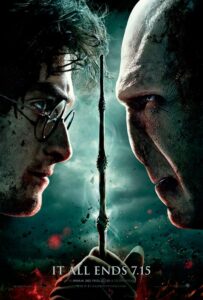
 It all ends. And to be sure, “Harry Potter and the Deathly Hallows: Part 2” does bring the storied franchise to a fitting end. Perhaps no other series of films has delivered consistent high quality in terms of visuals and narrative better than “Potter.” The event that is “Part 2” can be called nothing less than epic.
It all ends. And to be sure, “Harry Potter and the Deathly Hallows: Part 2” does bring the storied franchise to a fitting end. Perhaps no other series of films has delivered consistent high quality in terms of visuals and narrative better than “Potter.” The event that is “Part 2” can be called nothing less than epic.
Picking up where “Part 1” left us, Harry grieves by the seaside grave of the fallen Dobby. His gravestone reads “A Free Elf.” The death of Dobby left moviegoers, even those schooled on and prepared by the source material, gutted. It is one thing to absorb the pathos from the words on the written page, but the movie medium can bring those words to life. Of course, without reverent retelling of the story crafted by the novel’s author, the words become hollow on the screen. And over the course of now 8 films, the Potter franchise has tried on 4 directors but just 2 writers finding success and failure through numerous evolutions. All the while the three actors (Daniel Radcliffe, Emma Watson, and Rupert Grint) at the center remained constant only growing older and more mature along with hoards of avid fans. Like the actors themselves, fans have literally grown up with Potter.
The story, well known now to all, involves a constant battle between the innocent Harry Potter (Radcliffe) and his youthful schoolmates with the forces of evil led by Lord Voldemort (Ralph Fiennes), often referred to as “He-Who-Must-Not-Be-Named.” As the films progressed, the tendency has been to avoid happy endings. This was especially true for “Part 1” that ended with the loss of that free elf, who managed to pull so well at our heartstrings. Prepare yourself for much loss in “Part 2” a sweeping narrative that remarkably answers all the nagging questions without feeling overly rushed or contrived, even for a film about a child wizard.
Those of you who grumbled cynically that the seventh book in the series was divided into 2 parts can be silenced. Not only does this good thing finally end, but stretching book 7 over movies 7 and 8 provides necessary breathing room to explain things. As Harry himself tells the goblin (Warwick Davis) in one of the film’s quieter opening sequences “it’s complicated.”
And it is the intricate nature of the entire octology that makes the Potter universe credible. The vast number of characters that have been brought from the pages of the novels to the screen is in and of itself impressive. But what screenwriter and Potter mainstay Steve Kloves does with the script in “Part 2” tying those characters all together and giving them meaningful parts is nothing less than masterful. This means that we are free to excuse “Part 2’s” flights of fancy, like a fiery action sequence in a hidden room where escape follows a familiar movie formula, or a denouement that feels a bit padded. That final dalliance is reminiscent of the lengthy epilogue causing “The Lord of the Rings: The Return of the King” to be an utter bladder buster. And yet, “Part 2,” which clocks in at 130 minutes, will not likely cause your mind to wander. Even the quiet moments in this film will have viewers captivated.
But the largest miscalculation is likely the shameless addition of 3D to the series ender. To put it bluntly: 3D adds nothing to the movie and can possibly damage the experience. While I was overwhelmingly negative on the year’s biggest film to date, “Transformers: Dark of the Moon,” I recognized that the top-shelf effects and the 3D were perfect for the material. 3D seems to work best when applied to films featuring a lot of hard edges and flat surfaces. Perhaps, that is why the 3D gimmick was very effective when applied to “Cars 2.” But “Harry Potter and the Deathly Hallows: Part 2” is set in a very organic environment—a lot of soft edges and curvy surfaces. Combine that with the overly dark look and gauzy images and so much of the film looks positively out of focus in 3D. It was frustrating. And while “Part 2” is a big cinematic deal, 3D comes off as a business ploy and less of a true creative choice.
The cynics should turn their ire on the geniuses that have condemned us to watching movies through tinted glasses. No self-respecting Potter fan really shed a tear when it was announced that “Part 1” would only be released in 2D, and its addition here is not worth paying for. But the marketing gurus came up with another trump card—limited edition Harry Potter 3D glasses will be issued to those paying for the 3D ticket. One wonders how many pairs of such glasses will be available after the film’s huge opening days.
But the quibble over the technical aspects of the film rightfully take a backseat to the real reason why people will stand in line, in the heat and the rain, to be one of the first to see this end: Harry Potter is a great movie character. The story depends so much on caring for Harry. Played with timidity by the ever-boyish Daniel Radcliffe, we first met Harry as he made his bed under the stairs in the unwelcoming home of a relative. Cast out because he was different, the bespectacled Harry won us over with each installment in the series managing, often awkwardly, to combat the forces of Voldemort with pure goodness. But as students of the books know, Harry’s innocence is but part of his defense. And the grand plan, politics and treachery, play out in “Part 2” in a clever and challenging manner. The meaning of it will be analyzed in years to come. What started out in 2001 as a kid’s fantasy has matured into something of surprising import and lasting impact.
The end of “Part 2,” of course, leaves open the possibility for a new beginning. However, another Potter film isn’t likely to be forth coming any time soon. This is one popular epic that closes the book eloquently with style and substance leaving fans with images that brings to life J. K. Rowling’s treasured words.
